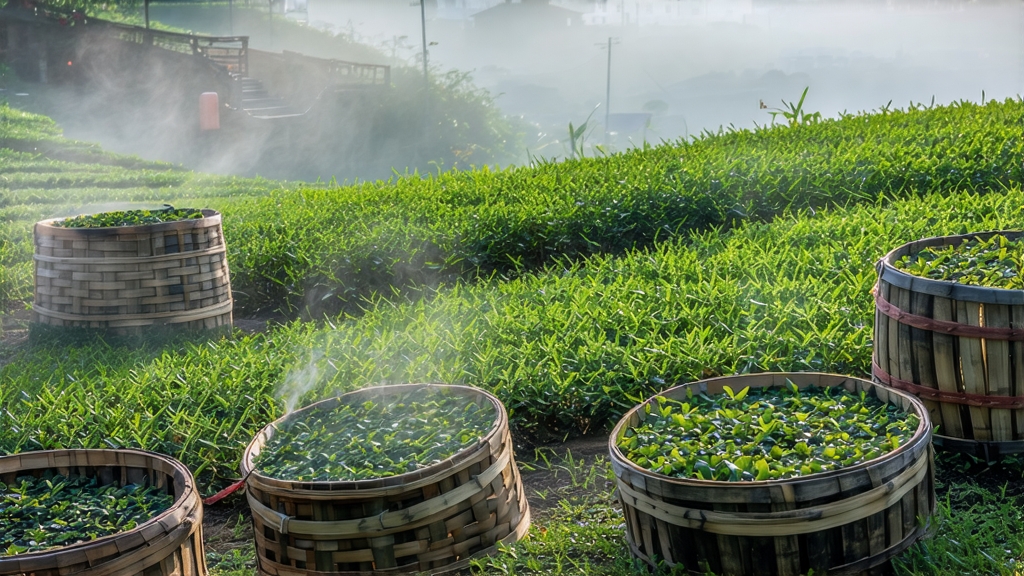
Tucked away in the southern folds of China’s Guangxi Zhuang Autonomous Region, Liu Bao tea has spent four centuries perfecting the art of quiet transformation. While Pu-erh grabs headlines, Liu Bao—literally “Six Forts”—has been the insider’s choice for merchants sailing the Pearl River, for dockworkers seeking digestion after greasy river-food, and for modern tea hunters who crave depth without spectacle. To understand Liu Bao is to watch time, microbes and human intuition collaborate inside a bamboo basket until a rough green leaf becomes a midnight-black, camphor-sweet liquor that tastes like old library and rainforest at once.
History: From River God Tribute to Global Cup
The earliest written record appears in 1620, when the Xixian county gazetteer notes “dark tea from Liu Bao, bartered for salt in Wuzhou.” Junks carried it downstream to Guangzhou, where the British East India Company bought it as “bohea extra” to ballast clippers crossing the Indian Ocean. During the Qing dynasty it was pressed into 37-kilogram bamboo baskets, stamped with the imperial phoenix, and floated north to Beijing’s palace kitchens who valued its ability to cut through mutton fat. In 1886 the tea accounted for 28 % of Guangxi’s export revenue, but wars and railway shifts pushed it into obscurity. Revival began in 2004 when a single 1958 basket fetched USD 30 000 at a Shenzhen auction, alerting collectors that Liu Bao ages with the grace of Burgundy yet costs less than a weekend hotel.
Terroir: Karst Hills and River Fog
The original six forts—Liu, Wu, Yong, Fu, Xian, and He—sit where the Lian River cuts through limestone towers. Day-night temperature swings of 15 °C force the tea bush (a large-leaf varietal related to Camellia sinensis var. assamica) to thicken cell walls, storing fructose and minerals. Microscopic karst springs keep soil pH at 5.2, ideal for polyphenol synthesis. Most gardens sit between 200–500 m, too low to qualify as “high mountain” in Yunnan standards, yet the constant fog refracts sunlight into soft, silver wavelengths that slow photosynthesis and concentrate amino acids. Locals insist the river’s camphor-forest breezes seed the leaf with airborne microbes years before those microbes are invited to feast during fermentation.
Craft: The Secret Wet Piling Dance
Liu Bao is the only Chinese dark tea that relies on “wet piling” centuries before Pu-erh adopted the technique. Fresh leaves are solar-wilted for 30 minutes, then wok-fried at 280 °C for eight minutes to kill green enzymes while preserving leaf integrity. After rolling, the maocha is heaped 70 cm high on bamboo mats and misted with 28 % moisture water drawn from the same limestone aquifers. The pile is covered with jute sacks and left for 10–12 hours; internal temperature climbs to 55 °C, triggering thermophilic bacteria that oxidize catechins into theaflavins and theabrownins. A master “dui-zi” inserts a long bamboo thermometer every hour; when the core hits 58 °C he quickly turns the pile to aerate, a maneuver called “fan dui” that prevents anaerobic spoilage. This cycle repeats four times over 36 hours, after which the tea is sun-dried, then steamed and packed into 40 kg bamboo baskets lined with fresh banana leaf. The banana leaf adds lactobacillus while allowing micro-oxygenation, so fermentation continues for decades. A 1950s basket opened in 2020 still registered 11 % moisture, proof that the tea breathes.
Styles and Grades
- Traditional Basket (40 kg): loose leaf, deepest fermentation, camphor-herb aroma.
- Brick (250 g): pressed from 5th-grade leaves, faster aging, cocoa note.
- Orange-Liu Bao: stuffed inside sun-dried tangerine peel, citrus oil perfumes the tea within months.
- Aged Loose (pre-1990): auction stars, reddish-black leaves, orchid-bittersweet finish.
- Modern “Light Fermentation” (8-hour piling): greener leaf, plum acidity, aimed at cold-brew market.
Aging: The Bamboo